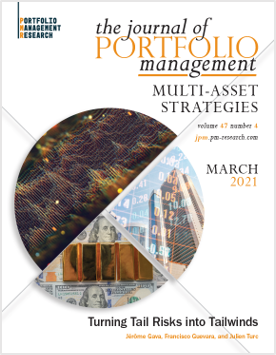Quantitative Investments strategists, who develop advanced mathematical models to detect investment opportunities, claim that their models perform well in all market conditions, but how did quantitative investment strategies (QIS) hold up in 2020’s unprecedented volatility?
In “Turning tail risks into tailwinds”, a recent research paper published in The Journal of Portfolio Management, the BNP Paribas QIS Lab demonstrated that multi-asset portfolio strategies that consider tail risks [1] can successfully mitigate losses.
The dramatic market moves in 2020 stressed the importance of both careful risk management and rigorous decision-making.
Systematic strategies [2] really proved themselves during the crisis. Investors were keen to rebalance their position systematically or access liquidity at fixed prices to protect against market movements, and this is exactly what QIS was able to provide.
“With less opportunity for frequent interactions during the pandemic, the QIS Lab focused on providing more in-depth research on fundamental topics. Investors have been paying more attention to thorough research papers in this new context, showing that research is more important than ever for them
Julien Turc, Head of QIS Lab, Global Markets, BNP Paribas
As the pandemic unfolded, the QIS Lab team had already started their research into tail risks.
Before designing the actual model, the QIS Lab team first went back to the academic fundamentals, reviewing the theoretical foundations of how to measure the risk of an extreme market move, as well as attempting to model the way investors make decisions.
Their research findings answer the following questions:
- Particularly interesting for Chief Investment Officers (CIOs) and asset allocators, they investigated alternatives to bonds for protecting portfolios, and how investors can hope to protect their portfolio in any future crisis if yields are at rock-bottom lows. They found that certain systematic strategies can perform well in market turmoil. Rather than relying on bonds solely for protecting their portfolio, investors could discuss these strategies with the QIS Lab team as well.
- Focusing more on risk managers and asset allocators, the research looked at how to mitigate downside risk for portfolio allocation. The risk models considered in the paper provide relatively long-term guidelines for weighting portfolios, in contrast with tactical signals that may trigger entirely exiting or entering positions in certain circumstances.
- Finally, and more relevant for quantitative investors, the research explored the best approach to risk parity [3]. One of the findings was that minimising extreme downside risk leads to efficient and robust portfolios. The study provides empirical and theoretical evidence on the benefits of measuring risks by focusing on worst-case scenarios.
As the QIS Lab team continues to innovate and deep dive into the fundamental topics of their research work, they also focus on understanding how systematic models react to extreme market moves such as those seen during the pandemic. Investors are more and more in tune with this as they understand the power of quantitative investment strategies for more careful risk management and rigorous decision-making.
[1] Risk of sustaining losses that go far beyond past experience
[2] Investment decisions based on algorithmic rules
[3] A way of building portfolios that is based on estimated risk rather than invested amount of money
Not connected to BRIO yet? Request a demo
This paper has been promoted in the renown media below

